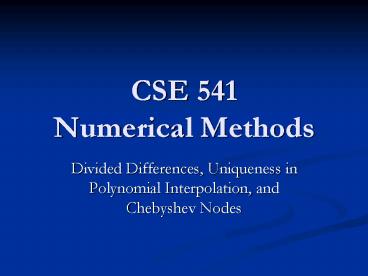CSE 541 Numerical Methods PowerPoint PPT Presentation
1 / 27
Title: CSE 541 Numerical Methods
1
CSE 541Numerical Methods
- Divided Differences, Uniqueness in Polynomial
Interpolation, and Chebyshev Nodes
2
Example ln(2)
- Given ln(1), ln(4), and ln(6)
- (x0, f0), (x1, f1), (x2, f2) Þ (1, 0), (4,
1.3863), (6, 1.79176)
Note the divergence for values outside ofthe
data range
3
Linear Interpolation
- p1(x) b0 b1(x x0)
- 0 (1.3863-0)/(4-1)(x-1)
- 0.4621(x - 1)
- p1(2) 0.4621
4
Quadratic Interpolation
- p2(x) b0 b1(x x0) b2(x x0)(x x1)
- 0 0.4621(x-1)(((1.7918 1.3863)/(6-4)-
- (1.3863-0)/(4-1))/(6-1))(x-1)(x-4)
- 0.4621(x-1) - 0.051874(x-1)(x-4)
- p2(2) 0.5658
Same approximation as Lagrange Well that was a
quadratic also! Oh yes, uniqueness!
5
Example ln(x)
- Observation
- Quadratic interpolation catches some of the
curvature - Linear plus higher order correction
- Improves the result somewhat
- Does that mean that the higher the degree the
better our results? - Not necessarily tune in later
6
Calculating The Divided-Differences
- Incrementally construct a divided-difference
table - Consider eight samples and the function ln(x)
- Compute bi starting from b0
7
Calculating The Divided-Differences
Calculate b1
Calculate needed values for the next step
8
Calculating The Divided-Differences
Calculate b2
9
Calculating The Divided-Differences
Calculate b3
10
Calculating The Divided-Differences
Calculate b4
11
Calculating The Divided-Differences
Calculate b5
12
Calculating The Divided-Differences
Calculate b6
13
Calculating The Divided-Differences
- Finally, we can calculate the last coefficient
Calculate b7
14
Calculating The Divided-Differences
- Remember, all of the coefficients for the
resulting polynomial are in bold - Can use Excel to construct this table very easily!
b0
b4
b7
15
Polynomial Form
- Insert the divided-differences into the final
polynomial
Divided Differences diagonal values of the table
16
Many polynomials
- The order of the numbers (xi, yi)s only matters
when writing the polynomial down - The first column in the table represents pairs of
adjacent points connected linearly - i.e. linear splines
- The second column gives us quadratics thru three
adjacent points - Etc.
17
Adding an Additional Data Point
- Easy to add another row to the table
- Hence, only n additional divided-differences need
to be calculated for the n 1st data points
b8
18
Uniqueness
- Let pn(x) and qn(x) be two different polynomials
of degree n (or less) that both interpolate n 1
data points - Let rn(x) be the subtraction of these two
polynomials - Þ Polynomial rn(x) has at most degree n
19
Uniqueness
- The n 1 data points are roots of rn(x)
- Since both pn(x) and qn(x) interpolate the n 1
data points - A polynomial of degree n can only have at most n
roots - But, we established that rn(x) can have degree at
most n - A Contradiction!!!!!!
- Therefore, rn(x) ? 0
20
Error
- Define the error term
- If f (x) is an nth order polynomial pn(x) is of
course exact - Otherwise, this function has at least n 1 roots
at the interpolation points - Since there is a perfect match at x0, x1,,xn
21
Interpolation Errors
- We already have a feel for what these divided
differences represent - Corollary 1 in book If f (x) is a polynomial of
degree m lt n, then all (m 1)th divided
differences and higher are zero
22
Interpolation Errors
- Intuitively, the first n 1 terms of the Taylor
Series is also an nth degree polynomial - Proof is in the book.
23
Interpolation Errors
- Use the point x to expand the polynomial
- Point is, we can take an arbitrary point x, and
create an (n 1)th polynomial that goes thru the
point x
24
Choosing Data Points
- Given an interval a, b of interest, how do we
choose data points? - Divide into equal sized subintervals
- First two are the endpoints, the next point is
the mid-point, followed by successive mid-points
of the half-intervals - How many data points?
- More means higher order approximation
- Does this translate to better?
25
Problems with Polynomial Interpolation
- Is it always a good idea to use higher and higher
order polynomials? - No Usually 3-4 points is good and 5-6 points ok
- Too high a degree causes wiggles
- Particularly for sharp edges
26
Sample Point DistributionChebyshev Nodes
- Equally distributed points is the easy way
- This may not be the optimal solution
- If you could select the xis unevenly, what would
they be? - Want to minimize the term
- Chebyshev nodes
- For x -1 to 1, define
27
Chebyshev nodes
- Lets look at these for n 4
- Spreads the points out inthe center

